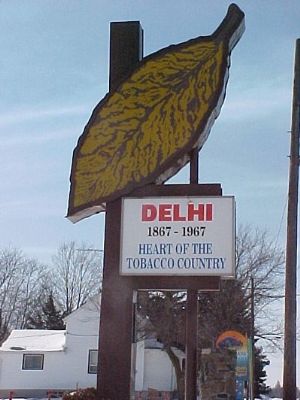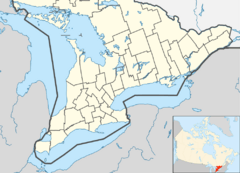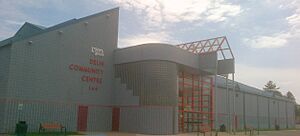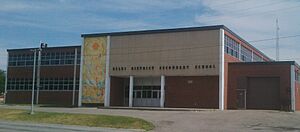Delhi, Ontario facts for kids
Quick facts for kids
Delhi, Ontario
|
|
|---|---|
|
Unincorporated hamlet in Norfolk County
|
|
 |
|
| Motto(s):
"The heart of tobacco country"
|
|
| Country | |
| Province | |
| Established | 1826 as Sovereen's Corners |
| Incorporated | 1893 |
| Amalgamated into Delhi Township | 1974 (Regional Municipality of Haldimand-Norfolk) |
| Amalgamated into Norfolk County | 2001 (Single-tier municipality) |
| Area | |
| • Land | 2.97 km2 (1.15 sq mi) |
| Elevation | 210 m (690 ft) |
| Population
(2011)
|
4,172 |
| • Density | 1,405.4/km2 (3,640/sq mi) |
| Time zone | UTC-5 (EST) |
| • Summer (DST) | UTC-4 (EDT) |
| Forward sortation area |
N4B
|
| Area code(s) | (519), (226) |
| Website | www.norfolkcounty.ca |
Delhi (pronounced DEL-hy) is a community in Norfolk County, Ontario, Canada. It's located where two main roads, Ontario Highways 59 and 3, meet. Delhi is famous for being the "Heart of Tobacco Country." Before the 1880s, it was known for its lumber industry. In 2016, about 4,240 people lived in Delhi.
The area was first settled around 1812 by Frederick Sovereign. It was first called Sovereign's Corners. Later, it was renamed Fredericksburg. In 1856, it got its current name, Delhi. Many believe the name came from a postmaster who wanted to honor the big city of Delhi, India.
Contents
History of Delhi
Frederick Sovereign settled in this area around 1812. His family had moved from Germany to New Jersey. They then came to Norfolk County in Canada because of the Revolutionary War in the U.S. Frederick Sovereign was a tavern owner for over 30 years. He also made tobacco, growing and processing his own leaves. He gave land for the Baptist church and was a church leader for many years.
By 1869, Delhi had about 300 people. It had factories and a lumber mill, thanks to good water power. The post office received mail every day. The railway arrived in the 1870s, which helped local businesses. For example, the Delhi Canning Company started in 1878. It shipped canned local food all over Canada.
The first school in the village was a log cabin. A new school building was built in 1892. Around 1900, Delhi had an opera house and two leather factories. It also had a train station and a flour mill. At that time, the main crops grown in the area were fruits and vegetables.
Delhi Cemetery
The Delhi Cemetery was created in the 1800s. It was first only for members of the Roman Catholic Church. Now, anyone can be buried there. More than 4,372 people or families are buried in this cemetery. Fifteen people from the Delhi area who died in the First World War are buried here. The names on the graves show many different backgrounds. These include English, French, Canadian, Eastern European, and Belgian families. Some Chinese families are also buried there. Many tombstones are written in languages other than English.
In the 1960s, Delhi had its own police station with a jail. Until the 1970s, most shops closed early on Wednesday afternoons. Later, laws changed, and businesses started staying open seven days a week.
In 1974, the Town of Delhi joined with other areas. This formed the Township of Delhi. In 2001, Delhi became part of the new Norfolk County.
Delhi's economy slowed down in the early 2000s. This happened because the tobacco industry declined. This problem also affected other areas in the Ontario tobacco belt. People in Delhi say that farming became less profitable.
Quance Dam and Train Station History
Quance Dam had very high water levels in 2009. However, recent dry periods and damage to the old part of the dam are a concern. The dam has been partly unused since the 1930s. It was sold to the Quance family in 1987. A new part of Quance Dam was finished in 1995. Plans to turn it into a hydroelectric plant did not work out. Over 1000 fish pass through Quance Dam each year. This is much less than the 4000 fish that passed through in 1959. The fish population dropped because of dirt in the water and human development.
The St. Thomas and Eastern Railway started working in Delhi in 1998. This railway connects Delhi to places like St. Thomas and Tillsonburg. The main customer for the railway in Delhi is Growmark, Inc.
Before the 1970s, there was a train station for passengers. It was on the corner of William and Main streets. Trains were once the main way to ship goods. But trucks became faster and cheaper. This led to more truck traffic and smog in Delhi. Today, products like ethanol, rye, and fertilizer are shipped by truck between Delhi and St. Thomas.
Geography of Delhi
Delhi has hills on some roads, like Old Mill Road and William Street. Most of Delhi is flat. Older neighborhoods often do not have sidewalks. This can make walking difficult. Shops, a war memorial, and a park are close to homes. Walking around Delhi is generally easy.
A bus service connects Delhi to other towns. These include Simcoe, Port Dover, and Waterford. The bus runs Monday to Friday. There is no service on weekends or holidays.
A valley between Delhi and Lynedoch is about 5 kilometers (3 miles) long. It has parts of Ontario's original Carolinian forest. This forest covers over 1 square mile (2.6 square kilometers). The main highway to Port Talbot was built on an old Aboriginal trail.
North Creek flows into Big Creek in Delhi. Both creeks eventually flow into Lake Erie at Port Rowan.
Delhi's Climate
Delhi has a humid continental climate. This means winters are cold. The average temperature in January is about -5 degrees Celsius (23 degrees Fahrenheit). Most winter days stay below freezing. But sometimes, it can get warmer, even above 10 degrees Celsius (50 degrees Fahrenheit) in January. The average yearly snowfall is about 133 centimeters (52 inches). February usually has the most snow.
Summers are warm and humid. The average high temperature in July is about 27.5 degrees Celsius (81.5 degrees Fahrenheit). Temperatures above 30 degrees Celsius (86 degrees Fahrenheit) happen about 15 days a year. Delhi gets about 965 millimeters (38 inches) of rain each year. This rain is spread out evenly throughout the year. Delhi gets about 2021 hours of sunshine per year.
| Climate data for Delhi (1991-2020) | |||||||||||||
|---|---|---|---|---|---|---|---|---|---|---|---|---|---|
| Month | Jan | Feb | Mar | Apr | May | Jun | Jul | Aug | Sep | Oct | Nov | Dec | Year |
| Record high °C (°F) | 18.3 (64.9) |
16.0 (60.8) |
27.3 (81.1) |
29.5 (85.1) |
33.4 (92.1) |
36.7 (98.1) |
40.6 (105.1) |
36.7 (98.1) |
36.1 (97.0) |
31.7 (89.1) |
25.0 (77.0) |
19.5 (67.1) |
40.6 (105.1) |
| Mean daily maximum °C (°F) | −1.1 (30.0) |
−0.1 (31.8) |
5.1 (41.2) |
12.6 (54.7) |
19.9 (67.8) |
25.2 (77.4) |
27.5 (81.5) |
26.3 (79.3) |
22.4 (72.3) |
15.0 (59.0) |
8.0 (46.4) |
1.9 (35.4) |
13.6 (56.5) |
| Daily mean °C (°F) | −5.0 (23.0) |
−4.5 (23.9) |
0.3 (32.5) |
6.8 (44.2) |
13.6 (56.5) |
19.0 (66.2) |
21.2 (70.2) |
20.1 (68.2) |
16.4 (61.5) |
10.0 (50.0) |
3.9 (39.0) |
−1.7 (28.9) |
8.4 (47.1) |
| Mean daily minimum °C (°F) | −8.9 (16.0) |
−8.8 (16.2) |
−4.4 (24.1) |
1.1 (34.0) |
7.2 (45.0) |
12.8 (55.0) |
14.9 (58.8) |
14.0 (57.2) |
10.3 (50.5) |
4.9 (40.8) |
−0.2 (31.6) |
−5.0 (23.0) |
3.2 (37.8) |
| Record low °C (°F) | −33.9 (−29.0) |
−34.1 (−29.4) |
−25.0 (−13.0) |
−15.0 (5.0) |
−6.1 (21.0) |
−1.7 (28.9) |
3.3 (37.9) |
−0.6 (30.9) |
−3.9 (25.0) |
−9.4 (15.1) |
−18.9 (−2.0) |
−28.0 (−18.4) |
−34.1 (−29.4) |
| Average precipitation mm (inches) | 81.3 (3.20) |
58.0 (2.28) |
70.8 (2.79) |
87.4 (3.44) |
87.6 (3.45) |
81.5 (3.21) |
88.6 (3.49) |
79.5 (3.13) |
85.8 (3.38) |
86.1 (3.39) |
82.6 (3.25) |
76.3 (3.00) |
965.2 (38.00) |
| Average rainfall mm (inches) | 36.8 (1.45) |
30.0 (1.18) |
62.3 (2.45) |
79.7 (3.14) |
83.6 (3.29) |
83.2 (3.28) |
86.1 (3.39) |
85.8 (3.38) |
98.1 (3.86) |
83.5 (3.29) |
91.1 (3.59) |
57.6 (2.27) |
877.6 (34.55) |
| Average snowfall cm (inches) | 33.3 (13.1) |
29.7 (11.7) |
20.9 (8.2) |
5.6 (2.2) |
0.1 (0.0) |
0 (0) |
0 (0) |
0 (0) |
0 (0) |
0.5 (0.2) |
9.0 (3.5) |
33.7 (13.3) |
132.7 (52.2) |
| Average precipitation days (≥ 0.2 mm) | 14.4 | 12.4 | 12.6 | 13.0 | 11.9 | 10.4 | 10.5 | 9.4 | 11.3 | 11.6 | 13.8 | 14.6 | 146.0 |
| Average rainy days (≥ 0.2 mm) | 4.6 | 4.2 | 8.4 | 11.9 | 11.9 | 10.4 | 10.5 | 9.4 | 11.3 | 11.6 | 11.6 | 7.5 | 113.2 |
| Average snowy days (≥ 0.2 cm) | 10.5 | 9.0 | 5.2 | 1.4 | 0.04 | 0 | 0 | 0 | 0 | 0.12 | 2.4 | 8.3 | 37.0 |
| Mean monthly sunshine hours | 84.0 | 98.6 | 132.3 | 189.3 | 242.5 | 272.1 | 289.1 | 251.1 | 179.1 | 139.2 | 84.3 | 59.6 | 2,021.1 |
| Source 1: Environment Canada | |||||||||||||
| Source 2: Environment Canada | |||||||||||||
People of Delhi (Demographics)
Until 2001, Delhi was part of the Township of Delhi. This was a local government within the Regional Municipality of Haldimand-Norfolk. Delhi still has nearby neighborhoods like Pinegrove and Gilbertville. In 2001, the Township of Delhi had 16,365 people. Most residents were married and spoke English. They were born in Canada.
Delhi has several Roman Catholic churches. However, most residents in the early 2000s were Protestant. Many people in Delhi have family roots from the Dutch, Portuguese, Caribbean, Ukrainian, French, British, and First Nation groups.
As of 2016, most people in Delhi speak English as their first language. Most were also born in Canada. There are more females than males. There are also more working-age people than children or elderly people. By 2026, Delhi expects to have more older adults. Seventy people were born in the United States. About 250 were born in Europe. A few residents were born in Africa or Asia.
Delhi's Economy
Farming is still the main industry in Delhi. Tobacco and ginseng are the most important crops. Local farms get help from workers from the Caribbean and Central American countries. These workers usually arrive in April and go home in November. They are very important for farming in the area.
Delhi once had three factories: Delhi Industries, Delhi Foundry, and Delhi Metal Products. They all closed because Canada's economy changed. There are now more service jobs than factory jobs. Delhi Industries closed in 2010, causing 61 people to lose their jobs. They used to make fans for factories. Now, KAIN Logistics is in the old Delhi Industries building. This company helps other businesses with shipping and storage. Between 2012 and 2013, 2600 people in Norfolk County found jobs. Local businesses are slowly growing again. New ways of doing business have helped workers in Delhi. Delhi's economy might become more connected with bigger cities like Toronto.
Delhi has the only Your Independent Grocer store in Norfolk County. It is owned by Mr. and Mrs. Matt Wilkinson. The store is on Main Street in Delhi. It is a simple building with parking and shopping aisles. A drug store is also nearby.
As of 2017, eight medical doctors work in Delhi. The local health clinic was built in the mid-2000s. It is still growing to bring in more medical staff.
Sports in Delhi
Delhi is home to the Delhi Travellers. This is a junior hockey team that plays in the Southern Ontario Junior Hockey League. Delhi also has many teams for younger players. These include minor soccer, minor baseball, and minor hockey teams. Young people from ages three to 20 play these sports. Games are played at or near the Delhi Community Arena.
North Creek was once a very important place for fish to lay eggs. This changed when a dam was built in 1965. Before the 1960s, people loved to fish in the creek. Today, North Creek helps provide water to the town's water supply.
Education in Delhi
The local high school is Delhi District Secondary School. In the past, there were talks about closing it. But the local school board has decided to keep the school open for the future.
Famous People from Delhi
- Barry Boughner (born 1948), a retired NHL hockey player
- Earl Frederick Crabb (1899–1986), a flying ace from World War I
- John Leslie Hotson (1897–1992), a scholar who studied old English literature
- John A. Schweitzer (born 1952), an artist, art critic, and helper of good causes
- Ryan VandenBussche (born 1973), a retired NHL hockey player who grew up in Delhi





